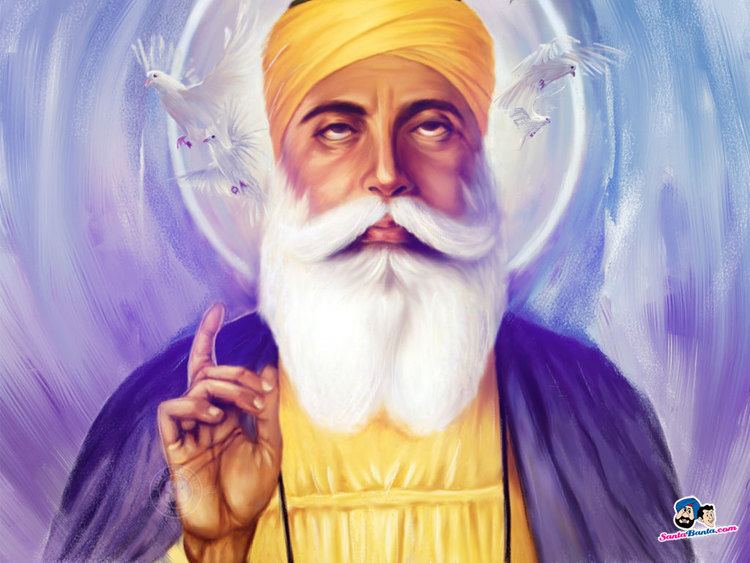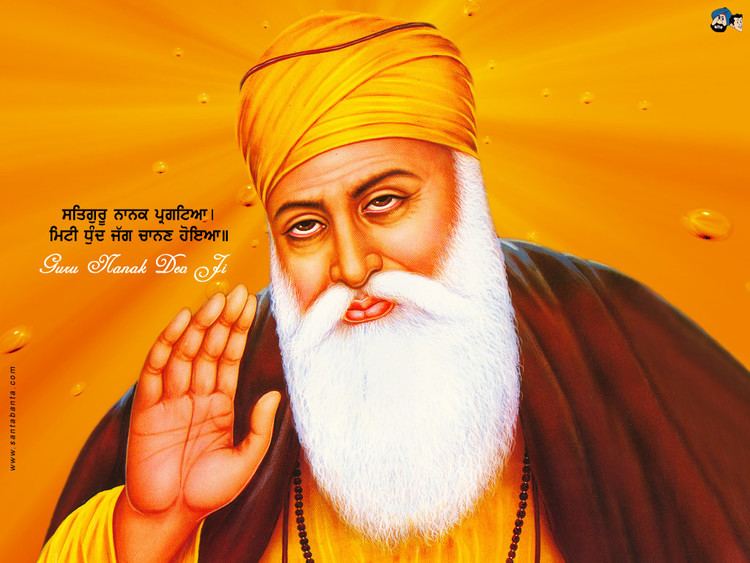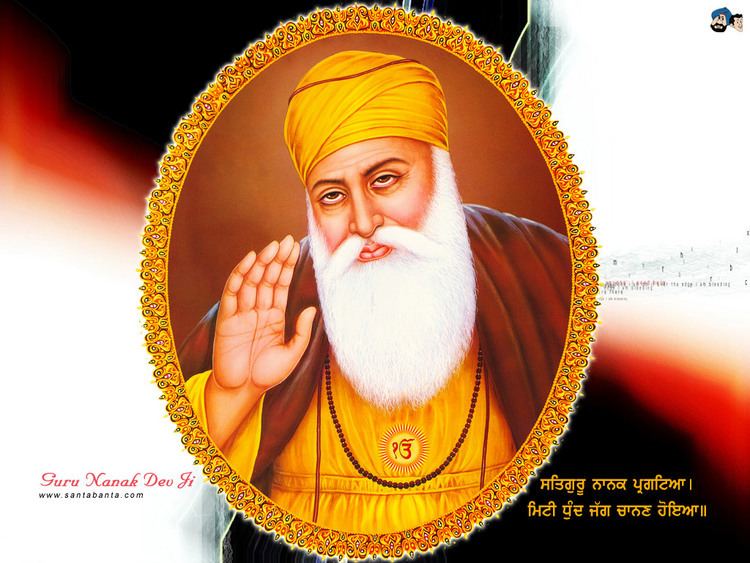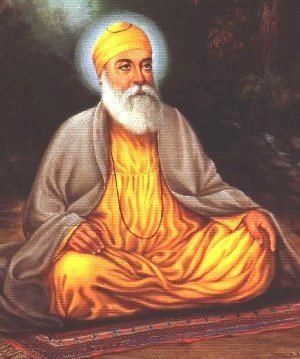Full Name Guru Nanak Name Guru Nanak Years active 1499–1539 | Spouse(s) Mata Sulakkhani | |
 | ||
Similar People | ||
REALITY BEHIND BABA GURU NANAK | FOUNDER OF SIKHISM | HISTORY OF GURU NANAK | KHOJI
Guru Nanak ([ˈɡʊɾu ˈnɑnək], pronunciation, IAST: Gurū Nānak) (1469 – 1539) was the founder of Sikhism and the first of the ten Sikh gurus. His birth is celebrated world-wide as Guru Nanak Gurpurab on Kartik Pooranmashi, the full-moon day in the month of Katak, October–November.
Contents
- REALITY BEHIND BABA GURU NANAK FOUNDER OF SIKHISM HISTORY OF GURU NANAK KHOJI
- The life of guru nanak animation divx
- Family and early life
- Biographies
- Sikhism
- Teachings
- Influences
- Journeys Udasis
- Succession
- References

Guru Nanak has been called "one of the greatest religious innovators of all time". He travelled far and wide teaching people the message of one God who dwells in every one of His creations and constitutes the eternal Truth. He set up a unique spiritual, social, and political platform based on equality, fraternal love, goodness, and virtue.

Guru Nanak's words are registered in the form of 974 poetic hymns in the holy text of Sikhism, the Guru Granth Sahib, with some of the major prayers being the Japji Sahib, the Asa di Var and the Sidh-Ghost. It is part of Sikh religious belief that the spirit of Guru Nanak's sanctity, divinity and religious authority descended upon each of the nine subsequent Gurus when the Guruship was devolved on to them.

The life of guru nanak animation divx
Family and early life

Nanak was born on 15 April 1469 at Rāi Bhoi Kī Talvaṇḍī (present day Nankana Sahib, Punjab, Pakistan) near Lahore. His parents were Kalyan Chand Das Bedi, popularly shortened to Mehta Kalu, and Mata Tripta. His father was the local patwari (accountant) for crop revenue in the village of Talwandi. His parents were both Hindus and belonged to the merchant caste.
He had one sister, Bebe Nanaki, who was five years older than he was. In 1475 she married and moved to Sultanpur. Nanak was attached to his sister and followed her to Sultanpur to live with her and her husband, Jai Ram. At the age of around 16 years, Nanak started working under Daulat Khan Lodi, employer of Nanaki's husband. This was a formative time for Nanak, as the Puratan (traditional) Janam Sakhi suggests, and in his numerous allusions to governmental structure in his hymns, most likely gained at this time.
According to Sikh traditions, the birth and early years of Guru Nanak's life were marked with many events that demonstrated that Nanak had been marked by divine grace. Commentaries on his life give details of his blossoming awareness from a young age. At the age of five, Nanak is said to have voiced interest in divine subjects. At age seven, his father enrolled him at the village school as was the custom. Notable lore recounts that as a child Nanak astonished his teacher by describing the implicit symbolism of the first letter of the alphabet, resembling the mathematical version of one, as denoting the unity or oneness of God. Other childhood accounts refer to strange and miraculous events about Nanak, such as one witnessed by Rai Bular, in which the sleeping child's head was shaded from the harsh sunlight, in one account, by the stationary shadow of a tree or, in another, by a venomous cobra.
On 24 September 1487 Nanak married Mata Sulakkhani, daughter of Mūl Chand and Chando Rāṇī, in the town of Batala. The couple had two sons, Sri Chand (8 September 1494 – 13 January 1629) and Lakhmi Chand (12 February 1497 – 9 April 1555). Sri Chand received enlightenment from Guru Nanak's teachings and went on to become the founder of the Udasi sect.
Biographies
The earliest biographical sources on Nanak's life recognised today are the Janamsākhīs (life accounts). Bhai Gurdas, a scribe of the Gurū Granth Sahib, also wrote about Nanak's life in his vārs. Although these too were compiled some time after Nanak's time, they are less detailed than the Janamsākhīs. The Janamsākhīs recount in minute detail the circumstances of the birth of the guru.
Gyan-ratanavali is attributed to Bhai Mani Singh who wrote it with the express intention of correcting heretical accounts of Guru Nanak. Bhai Mani Singh was a disciple of Guru Gobind Singh who was approached by some Sikhs with a request that he should prepare an authentic account of Guru Nanak’s life.
One popular Janamsākhī was allegedly written by a close companion of the Guru, Bhai Bala. However, the writing style and language employed have left scholars, such as Max Arthur Macauliffe, certain that they were composed after his death. According to the scholars, there are good reasons to doubt the claim that the author was a close companion of Guru Nanak and accompanied him on many of his travels.
Sikhism
Nanak was a Guru (teacher), and founded Sikhism during the 15th century. The fundamental beliefs of Sikhism, articulated in the sacred scripture Guru Granth Sahib, include faith and meditation on the name of the one creator, unity of all humankind, engaging in selfless service, striving for social justice for the benefit and prosperity of all, and honest conduct and livelihood while living a householder's life.
The Guru Granth Sahib is worshipped as the Supreme Authority of Sikhism and is considered the eleventh and final guru of Sikhism. As the first guru of Sikhism, Guru Nanak contributed a total of 974 hymns to the book.
Teachings
Nanak’s teachings can be found in the Sikh scripture Guru Granth Sahib, as a collection of verses recorded in Gurmukhi.
There are two competing theories on Guru Nanak's teachings. One, according to Cole and Sambhi, is based on hagiographical Janamsakhis, and states that Nanak's teachings and Sikhism were a revelation from God, and not a social protest movement nor any attempt to reconcile Hinduism and Islam in the 15th century. The other states, Nanak was a Guru. According to Singha, "Sikhism does not subscribe to the theory of incarnation or the concept of prophethood. But it has a pivotal concept of Guru. He is not an incarnation of God, not even a prophet. He is an illumined soul."
The hagiographical Janamsakhis were not written by Nanak, but by later followers without regard for historical accuracy, and contain numerous legends and myths created to show respect for Nanak. The term revelation, clarify Cole and Sambhi, in Sikhism is not limited to the teachings of Nanak, they include all Sikh Gurus, as well as the words of past, present and future men and women, who possess divine knowledge intuitively through meditation. The Sikh revelations include the words of non-Sikh bhagats, some who lived and died before the birth of Nanak, and whose teachings are part of the Sikh scriptures. The Adi Granth and successive Sikh Gurus repeatedly emphasised, states Mandair, that Sikhism is "not about hearing voices from God, but it is about changing the nature of the human mind, and anyone can achieve direct experience and spiritual perfection at any time". Guru Nanak emphasised that all human beings can have direct access to God without rituals or priests.
The concept of man as elaborated by Guru Nanak, states Arvind-pal Singh Mandair, refines and negates the "monotheistic concept of self/God", and "monotheism becomes almost redundant in the movement and crossings of love". The goal of man, taught the Sikh Gurus, is to end all dualities of "self and other, I and not-I", attain the "attendant balance of separation-fusion, self-other, action-inaction, attachment-detachment, in the course of daily life".
Guru Nanak, and other Sikh Gurus emphasised Bhakti, and taught that the spiritual life and secular householder life are intertwined. In Sikh worldview, the everyday world is part of the Infinite Reality, increased spiritual awareness leads to increased and vibrant participation in the everyday world. Guru Nanak, states Sonali Marwaha, described living an "active, creative, and practical life" of "truthfulness, fidelity, self-control and purity" as being higher than the metaphysical truth.
Through popular tradition, Nanak’s teaching is understood to be practised in three ways:
Guru Nanak emphasised Nam Japna (or Naam Simran), that is repetition of God's name and attributes, as a means to feel God's presence.
Influences
Nanak was raised in a Hindu family and belonged to the Bhakti Sant tradition. Scholars state that in its origins, Guru Nanak and Sikhism were influenced by the nirguni (formless God) tradition of Bhakti movement in medieval India. However, Sikhism was not simply an extension of the Bhakti movement. Sikhism, for instance, disagreed with some views of Bhakti saints Kabir and Ravidas.
The roots of the Sikh tradition are, states Louis Fenech, perhaps in the Sant-tradition of India whose ideology grew to become the Bhakti tradition. Furthermore, adds Fenech, "Indic mythology permeates the Sikh sacred canon, the Guru Granth Sahib and the secondary canon, the Dasam Granth and adds delicate nuance and substance to the sacred symbolic universe of the Sikhs of today and of their past ancestors".
Journeys (Udasis)
Guru Nanak travelled extensively during his lifetime. Some modern accounts state that he visited Tibet, most of South Asia and Arabia starting in 1496, at age 27, when he left his family for a thirty-year period. These claims include Guru Nanak visiting the Mount Sumeru of Indian mythology, as well as Mecca, Baghdad, Achal Batala and Multan, in places he debated religious ideas with competing groups. These stories became widely popular in the 19th and 20th century, and exist in many versions.
The hagiographic details is a subject of dispute, with modern scholarship questioning the details and authenticity of many claims. For example, Callewaert and Snell state that early Sikh texts do not contain these stories, and after these travel stories first appear in hagiographic accounts of Guru Nanak centuries after his death, they continue to become more sophisticated over time, with the late phase Puratan version describing four missionary journeys (udasis), which however differs from the Miharban version. Some of the stories about Guru Nanak's extensive travels first appear in the 19th-century versions of janam-sakhi in the Puratan version. Further, stories about Guru Nanak's travel to Baghdad is absent from even the early 19th-century Puratan version. These embellishments and insertion of new stories, according to Callewaert and Snell, closely parallel claims of miracles by Islamic pirs found in Sufi tazkiras of the same era, and these legends may have been written in a competition.
Another source of dispute has been the Baghdad stone inscription in a Turkish script, which some interpret saying Baba Nanak Fakir was there in 1511-1512, other interpret it stating 1521-1522 (and that he lived in the Middle East for 11 years away from his family), while others particularly Western scholars stating that the stone inscription is from the 19th century and the stone is not a reliable evidence that Guru Nanak visited Baghdad in early 16th century. Further, beyond the stone, no evidence or mention of Guru Nanak's journey in the Middle East has been found in any other Middle Eastern textual or epigraphical records. Claims have been asserted of additional inscriptions, but no one has been able to locate and verify them. The Baghdad inscription remains the basis of writing by Indian scholars that Guru Nanak journeyed in the Middle East, with some claiming he visited Jerusalem, Mecca, Vatican, Azerbaijan and Sudan.
Novel claims about his travels, as well as claims such as Guru Nanak's body vanishing after his death, are also found in later versions and these are similar to the miracle stories in Sufi literature about their pirs. Other direct and indirect borrowings in the Sikh janam-sakhis relating to legends around Guru Nanak's journeys are from Hindu epics and Puranas and Buddhist Jataka stories.
Succession
Guru Nanak appointed Bhai Lehna as the successor Guru, renaming him as Guru Angad, meaning "one’s very own" or "part of you". Shortly after proclaiming Bhai Lehna as his successor, Guru Nanak died on 22 September 1539 in Kartarpur, at the age of 70.
